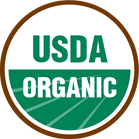If you care about buying organic food, you probably look for that little green and white label- “USDA ORGANIC.” It appears on everything from milk to cookies to boxed spinach. But what does it really mean?
Organic Categories
In the U.S., the USDA (the United States Department of Agriculture) regulates what can be classified as organic. By their definition, an organic ingredient has been produced without certain methods, called “excluded methods.” These include ionizing radiation, sewage sludge, specific pesticides, synthetic fertilizers and genetic engineering. There are 5 main categories a food product might fall into:
- 100% Organic
- Organic
- Made with Organic
- Specific Organic Ingredients
- Conventional (everything else)
The National Organic Program
 The National Organic Program, or NOP, is the government body (part of the USDA) that administers the label. Organic ingredients must be certified by an NOP-Accredited Agent or one authorized through an international trade partnership with the U.S. Currently, there are 56 domestic certification agencies accredited through NOP (like Oregon Tilth and Indiana Certified Organic) and 41 accredited foreign agencies.
The National Organic Program, or NOP, is the government body (part of the USDA) that administers the label. Organic ingredients must be certified by an NOP-Accredited Agent or one authorized through an international trade partnership with the U.S. Currently, there are 56 domestic certification agencies accredited through NOP (like Oregon Tilth and Indiana Certified Organic) and 41 accredited foreign agencies.
If you see the USDA Organic Label, it can mean:
100% Organic
This is as straightforward as it gets. To be 100% certified organic, all the ingredients and processing aids have to be certified organic through an NOP-accredited agency. The name of that agency must be listed on the label. Every organic ingredient has to be identified (by the word “organic” or with an asterisk or similar symbol).
These companies will often specify “100% Organic” somewhere on their labeling because, even though they aren’t required to use those exact words, they want consumers to know.
Organic
These foods can have the USDA Organic label, but allow up to 5% of the ingredients to be conventionally produced. The USDA has a ridiculously long document called The National List here that details what conventional ingredients may be included in foods labeled “Organic,” but good luck reading through the entire thing. We stumbled upon this handy list by blogger Food Babe that lists the ingredients in a condensed format.
As with 100% Organic, foods in this category must state the name of the certifying agency and identify all organic ingredients in the ingredient list.
If you don’t see a label, it can still be partly organic:
Made With Organic
At least 70% of the ingredients are certified organic. The remaining agricultural products not required to be organic, but must be produced without the excluded methods we mentioned above, while non-agricultural products have to be allowed per that long, long National List.
The label may state that the food was “Made With Organic” and list up to three ingredients. As always, the certifying agent must be listed and organic ingredients identified.
Specific Organic Ingredients
At this point you’re talking less than 70% organic ingredients, and they aren’t required to list the percentages or even the specific ingredients, though they can list them if they want to.
I’m left with a sense of how incredibly complicated it is to be certified organic. There’s miles of red tape and regulations, and that green and white label represents a significant investment of time and money on the part of a company.
